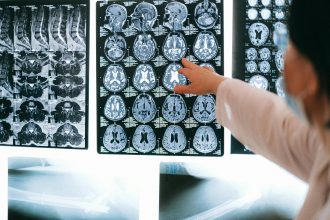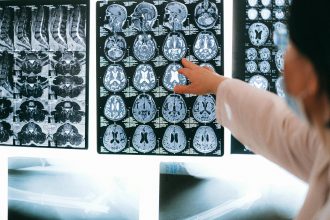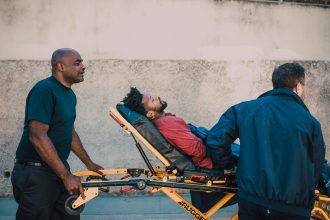An acquired brain injury (ABI) is damage to the brain that occurs after birth and is not caused by external trauma. Unlike concussions or traumatic injuries, ABIs result from medical conditions such as stroke, tumors, infections, or oxygen deprivation.
Although the cause differs, the effects can be just as profound — impacting movement, memory, speech, and personality. Understanding acquired brain injuries is essential for families navigating life after these medical events.
How ABI Differs from TBI
The main difference between an ABI and a traumatic brain injury (TBI) is the cause:
- TBI: Caused by an external force (fall, accident, assault, sports injury).
- ABI: Caused by internal medical conditions (stroke, hypoxia, tumor, infection).
Both can be mild, moderate, or severe, and both may require rehabilitation.
Causes of Acquired Brain Injury
Several medical events or conditions can lead to ABI:
Stroke
A stroke occurs when blood flow to the brain is interrupted (ischemic stroke) or when a vessel ruptures (hemorrhagic stroke). Stroke is the leading cause of ABI, often resulting in weakness, speech problems, and cognitive changes.
Hypoxic or Anoxic Brain Injury
When the brain receives reduced oxygen (hypoxia) or no oxygen (anoxia), cells begin to die within minutes. Causes include cardiac arrest, near-drowning, strangulation, or carbon monoxide poisoning.
Brain Tumors
Benign or malignant growths can press on or infiltrate brain tissue, disrupting normal function. Treatments such as surgery, chemotherapy, and radiation may also cause secondary damage.
Infections
Meningitis (inflammation of the brain’s protective membranes) and encephalitis (inflammation of brain tissue itself) can cause swelling, seizures, and long-term neurological problems.
Other Causes
- Toxic exposure (chemicals, drugs, alcohol)
- Neurological complications from metabolic conditions
- Brain hemorrhages not related to trauma
Symptoms of ABI
Symptoms vary depending on the cause, but may include:
- Weakness or paralysis (often on one side)
- Slurred speech or language problems
- Memory and concentration difficulties
- Emotional and behavioral changes
- Seizures or unexplained loss of consciousness
Some effects appear suddenly (as with stroke), while others develop gradually (as with tumors).
More detail on symptoms is available in Brain Injury Symptoms and Warning Signs.
Diagnosis
Doctors use a combination of tests to diagnose ABI:
- Neuroimaging: CT and MRI scans to identify bleeding, growths, or cell damage.
- EEG (electroencephalogram): To detect seizure activity.
- Blood tests and lumbar puncture: To diagnose infections or metabolic causes.
- Neuropsychological testing: To assess thinking, memory, and communication abilities.
Treatment
Treatment for ABI depends on the cause:
- Stroke: May involve clot-busting drugs, surgery, and rehabilitation.
- Hypoxic/Anoxic Injury: Requires rapid resuscitation and intensive care.
- Tumors: Managed with surgery, chemotherapy, radiation, or palliative care.
- Infections: Treated with antibiotics, antivirals, or steroids, often alongside intensive monitoring.
In all cases, once the immediate threat is managed, rehabilitation is critical for recovery.
See Brain Injury Rehabilitation for more on therapy approaches.
Recovery and Outlook
Recovery from ABI depends heavily on cause and severity. For example:
- Many stroke survivors regain independence with therapy, though some live with lasting deficits.
- Hypoxic injuries often have more severe outcomes, since widespread oxygen loss damages multiple brain regions.
- Tumor-related ABI outcomes depend on whether the tumor can be controlled or removed.
With rehabilitation, many people improve significantly, but recovery can take months or years.
Complications
Common complications following ABI include:
- Post-stroke depression
- Epilepsy after brain injury
- Long-term cognitive impairments
- Chronic fatigue
- Personality or behavior changes
Ongoing medical care, therapy, and community support play a vital role in quality of life.
Prevention
While not all ABIs can be prevented, steps can reduce risk:
- Managing high blood pressure, diabetes, and heart disease to lower stroke risk
- Avoiding smoking and excessive alcohol use
- Using carbon monoxide detectors in the home
- Seeking timely medical care for infections or unexplained neurological symptoms
Conclusion
Acquired brain injuries are a diverse but serious category of brain injury, caused by medical conditions rather than external trauma. Whether from stroke, lack of oxygen, tumors, or infections, their impact can be life-changing.
Early diagnosis, prompt treatment, and comprehensive rehabilitation help many survivors regain independence and quality of life. Families and caregivers who understand ABI are better equipped to navigate the challenges of recovery.







